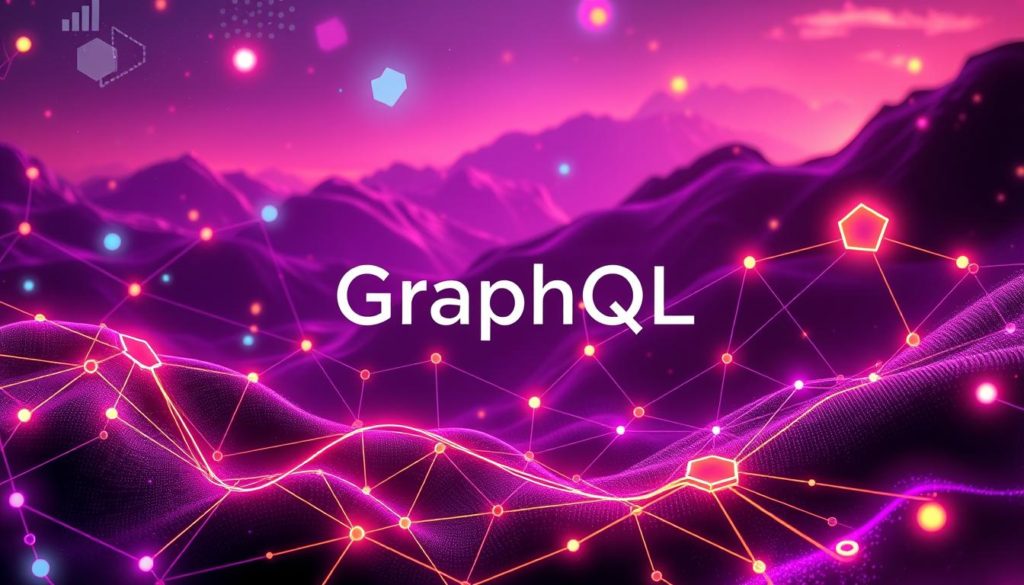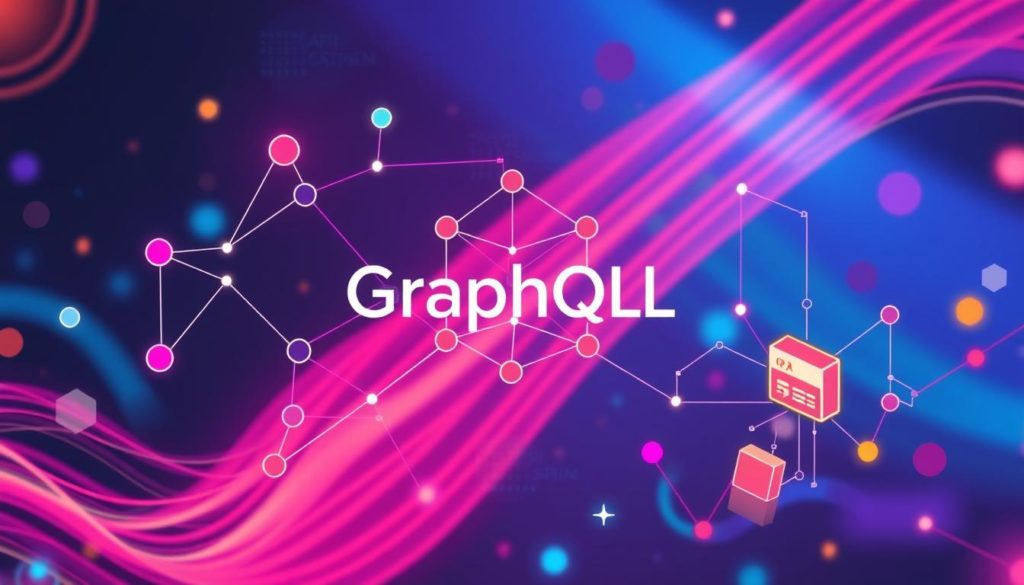
Did you know GraphQL can make data fetching faster? It lets developers ask for only the data they need from one place. This is different from REST APIs, which often need many requests to get all the data.
What is GraphQL? GraphQL was created by Facebook in 2012 and made open-source in 2015. It changed how we fetch data in apps. Now, big companies use GraphQL to handle billions of API calls every day.
In this guide, we explore GraphQL and its benefits. We’ll look at how it makes data fetching better, like reducing network requests. We’ll also show you how to use GraphQL in your projects with examples.
Learn about the advantages of GraphQL like flexible data fetching and a strongly typed schema. This makes your data queries more efficient.
Key Takeaways
- GraphQL was developed by Facebook and became open-source in 2015.
- It allows clients to request and retrieve specific data efficiently.
- The GraphQL query language helps reduce latency and bandwidth usage.
- A strongly typed schema ensures error-free queries before they are executed.
- GraphQL integrates seamlessly with existing databases and services.
What is GraphQL?
GraphQL is an open-source query language and runtime for APIs. Facebook created it in 2012 and made it public in 2015. It lets clients ask for just the data they need in one request. This solves the problems of getting too much or too little data found in REST APIs.
At its core, GraphQL is about giving clients exactly what they need. This is thanks to its strongly typed schema. It shapes data based on what the application needs.
A key benefit of GraphQL is its efficiency. Unlike REST APIs, which need multiple requests, GraphQL gets everything in one. This saves bandwidth, which is crucial for mobile and low-energy devices. GraphQL also makes it easy to query hierarchical and graph-structured data.
Companies like GitHub, PayPal, Glassdoor, and Twitter use GraphQL. They like its robust and flexible data-fetching mechanism. GraphQL also supports API versioning, allowing for incremental development.
Scalability is another big plus of GraphQL. It uses Federation to combine sub-graphs into one big graph. This lets front-end developers work on their own, without needing backend teams. API maintainers can also update fields without breaking queries.
In short, GraphQL is more than a query language. It’s a new way to build APIs that focuses on precision, efficiency, and flexibility. For developers, learning GraphQL basics can greatly improve their skills in building scalable and efficient apps.
Advantages of Using GraphQL
GraphQL is a powerful tool for fetching data, offering many benefits for developers and users.
Flexible Data Fetching
One key GraphQL benefit is its ability to let clients choose exactly what data they need. This avoids the problems of getting too much or too little data, common in REST APIs. It leads to more focused queries and optimized data payloads, making things simpler and easier to understand.
Also, clients have more control over the data they get. This means they can get the data they need more efficiently and accurately.
Strongly Typed Schema
GraphQL uses a strongly typed schema, acting as a contract between the client and server. Each query is linked to a specific type in the GraphQL schema. This setup ensures that data types are consistent and operations are valid, both for the client and server.
Data modeling in GraphQL schemas helps manage data types strictly. This leads to better error handling and smoother API interactions.
Reduced Network Requests
Another big GraphQL benefit is that clients can get all the data they need in one request. This cuts down on the number of trips to the server, saving bandwidth and improving network performance.
By reducing the data sent over the network, GraphQL makes apps run faster and respond quicker. Plus, queries are more focused, which reduces network overhead.
Schema Introspection
The GraphQL introspection feature is very useful. It lets clients ask the server about the types it supports. This feature helps understand the API better and makes creating queries easier.
GraphQL’s automatic documentation feature also makes the API self-explanatory. This helps with query validation and supports advanced tools like schema exploration and live validation.
| GraphQL Advantage | Benefits |
|---|---|
| Flexible Data Fetching | Prevents over-fetching/under-fetching, optimized data payloads, efficient data retrieval |
| Strongly Typed Schema | Ensures type safety, query validation, enhanced error management |
| Reduced Network Requests | Saves bandwidth, improves network performance, reduces latency |
| Schema Introspection | Facilitates automatic documentation, enhances developer experience |
Comparing GraphQL and REST
When we look at GraphQL vs REST, we see big differences. GraphQL uses one endpoint, unlike REST which has many. This makes GraphQL better for getting just what you need, without too much extra data.
GraphQL has three main ways to interact with data: Queries, Mutations, and Subscriptions. These are different from REST’s HTTP verbs. GraphQL also has a server-side schema, which helps find errors automatically. This is not something you have to do manually like with REST.
GraphQL is great for getting only the data you ask for. REST, on the other hand, sends back more data than needed. This makes GraphQL better for apps with lots of different data.
| Feature | GraphQL | REST |
|---|---|---|
| Endpoints | Single Endpoint | Multiple Endpoints |
| Data Fetching | Query for specific data | Entire resource structure |
| Error Handling | Automated via schema | Manual coding required |
| Real-Time Updates | Supported via Subscriptions | Not natively supported |
| API Backward Compatibility | Handled by deprecated fields | Versioning in URLs |
| Tooling and Libraries | GraphiQL, GraphQL Playground | Vast range of tools |
| Popularity | 29% of developers | 90% of developers |
The Postman report shows 86% of developers use REST APIs. GraphQL is used by 29%, but it’s growing. GraphQL is good for teams that need to ask for data in a flexible way.
In the GraphQL vs REST debate, GraphQL is more efficient. It’s great for businesses with changing needs and precise data needs. But for simpler needs, REST is still a good choice, thanks to its wide range of tools.
Implementing GraphQL in Your Project
Adding GraphQL to your project speeds up development and makes data use more efficient. We start by setting up a GraphQL server. Then, we define schemas and types, write resolver functions, and integrate with databases and services. Let’s explore each step.
Setting Up a GraphQL Server
The first step is setting up a GraphQL server. Tools like Apollo Server and Express-GraphQL make this easy. They handle the basics well, helping us build a solid GraphQL API.
Defining Schemas and Types
Using Schema Definition Language (SDL) to define schemas and types is key. This step outlines the data and operations the API supports. GraphQL schemas become self-explanatory, showing what data is available and how to access it.
Writing Resolver Functions
Resolvers are crucial in GraphQL. They connect schema fields to data-fetching operations. Good resolver functions are essential for working with databases and other data sources. They help fetch data accurately and handle queries efficiently.
Integrating with Existing Databases and Services
GraphQL works well with many databases and services. It allows for a unified API architecture through service aggregation. This makes data interaction consistent, improving project efficiency.
For more on GraphQL, check out the detailed guide at Apollo GraphQL.
| Aspect | Description |
|---|---|
| Server Setup | Using Apollo Server or Express-GraphQL for core functionalities. |
| Schemas & Types | Defining data structures and operations using SDL for a consistent API structure. |
| Resolvers | Mapping fields to data-fetching operations and writing effective resolver functions. |
| Database Integration | Seamlessly integrating with databases and services for efficient data management. |
Conclusion
GraphQL is a game-changer in API design. It was created by Facebook in 2012 and made open-source in 2015. Tech giants like GitHub, PayPal, and Netflix love it for its unique data management features.
Unlike REST APIs, GraphQL lets us get the exact data we need in one call. This makes development faster and more efficient. It’s a big win for performance.
GraphQL’s strong schema and self-documenting nature are huge for developers. They can quickly adapt to changes without worrying about versioning. It also cuts down on data waste, making apps more responsive, especially on mobile.
While REST is still good for some tasks, GraphQL brings unmatched flexibility and speed. Its benefits in targeted data, reduced server load, and easy schema access make it perfect for building fast, scalable APIs. Adopting GraphQL can give you an edge in the fast-paced world of app development.
FAQ
What is GraphQL?
GraphQL was first developed by Facebook. It’s a powerful query language and API runtime. Clients can ask for specific data they need, getting just that with one query. This solves the problems of getting too much or too little data with REST APIs.
What are the main advantages of using GraphQL?
GraphQL has many benefits. It lets clients fetch data flexibly and clearly. It also reduces network requests and makes APIs self-documenting through schema introspection.
How does GraphQL’s data fetching work?
GraphQL lets clients ask for exactly what they need. This makes it very efficient. It avoids the issues of getting too much or too little data seen in REST APIs.
What is a GraphQL schema?
A GraphQL schema is a contract between clients and servers. It defines data structure and permissible fields. This schema-driven approach helps with query validation and introspection.
How does GraphQL compare to REST?
GraphQL uses a single endpoint for all resources, unlike REST. This simplifies API management and makes querying complex data easier. It can also improve API performance.
What is the role of resolvers in GraphQL?
Resolvers are key in GraphQL. They map schema fields to data retrieval operations. They handle the logic behind the schema, connecting to databases and other sources.
How can GraphQL improve network performance?
GraphQL reduces network requests by batching multiple queries into one. This saves bandwidth and cuts down on server trips. It optimizes data exchange and lowers server load.
How do we start implementing GraphQL in a project?
To start with GraphQL, set up a server using Apollo Server or Express-GraphQL. Then, define schemas and types with SDL. Finally, write resolver functions to fetch data from sources.
What is schema introspection in GraphQL?
Schema introspection lets clients query the server for supported types. It helps understand the API better. It also supports dynamic queries, making GraphQL APIs self-documenting.
Future App Studios is an award-winning software development & outsourcing company. Our team of experts is ready to craft the solution your company needs.










